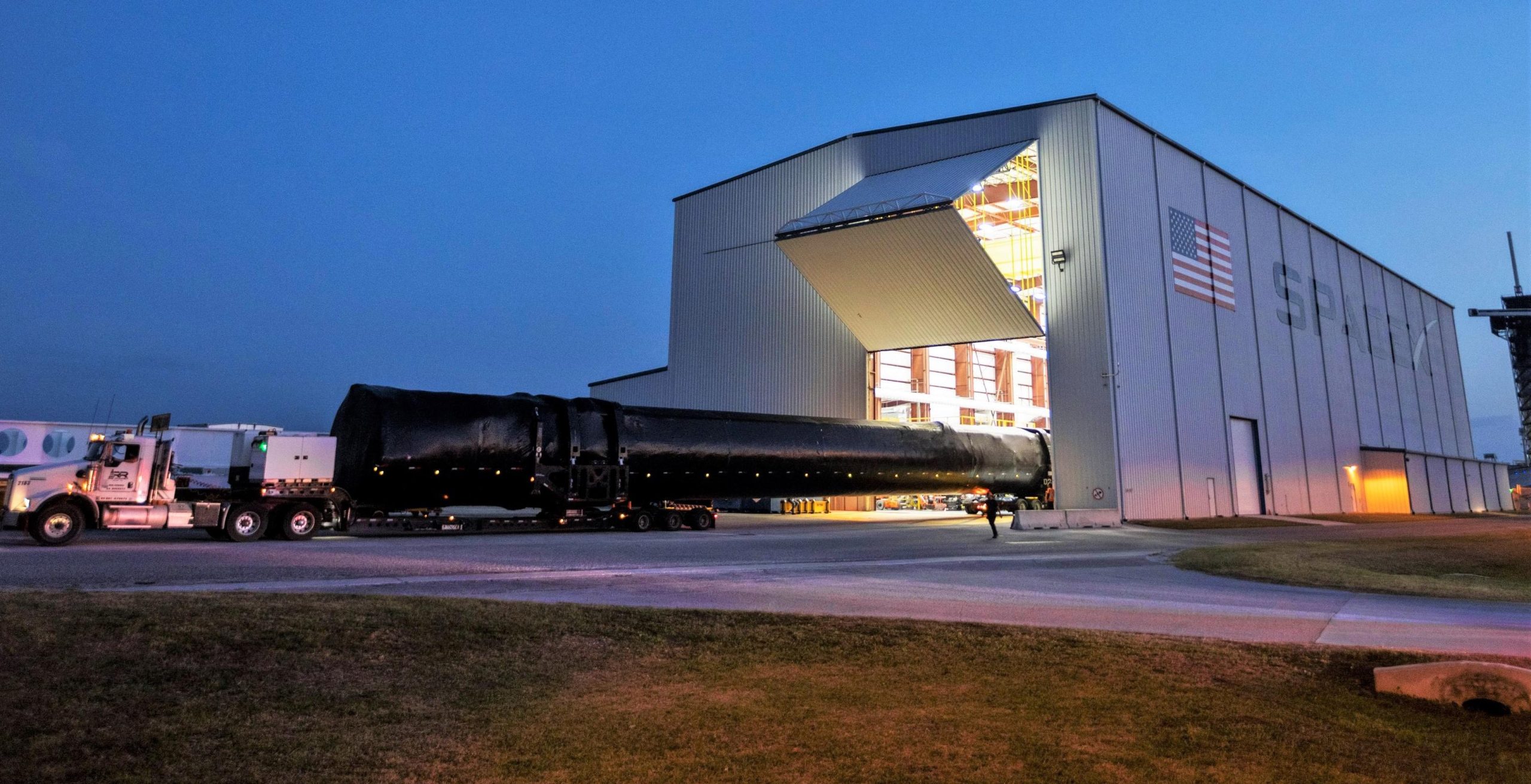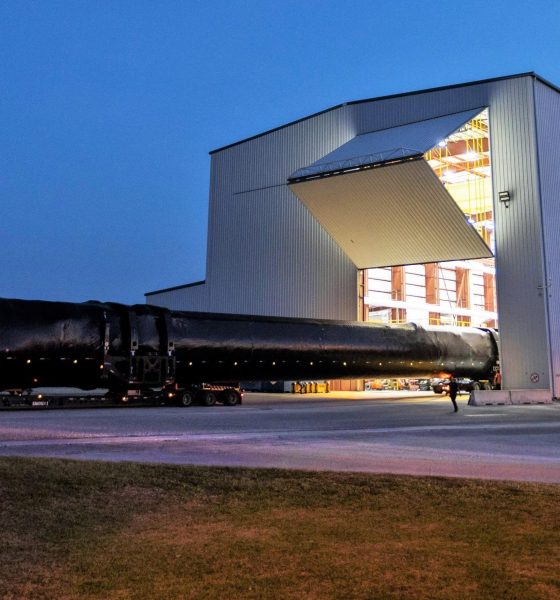

News
SpaceX’s next Falcon Heavy to usher Air Force into a new era of reusable rockets
After a few late-stage schedule tweaks, SpaceX’s third Falcon Heavy launch – set to deliver 24 spacecraft to a variety of orbits – is ready to usher the US Air Force into a new age of commercial rocket reuse as early as 11:30 pm ET (03:30 UTC), June 24th.
Split among the USAF, Department of Defense (DoD) research labs, NASA, NOAA, and a few US universities, STP-2’s 24 satellites will launch aboard SpaceX’s second Falcon Heavy Block 5 rocket. Both side boosters are flight-proven, having supported Falcon Heavy Block 5’s launch debut on April 11th, just 54 days ago. If all goes as planned, STP-2 will simultaneously give the USAF the data it needs to fully certify Falcon Heavy for all military launches and set the US military up to certify flight-proven commercial rockets for future launch contracts.
Signalling just how important the company feels this mission is, a dedicated STP-2 website created by SpaceX offers an excellent explanation of all aspects of the mission, from the technical to the strategic.
“The STP-2 mission will be among the most challenging launches in SpaceX history with four separate upper-stage engine burns, three separate deployment orbits, a final propulsive passivation maneuver and a total mission duration of over six hours. In addition, the U.S. Air Force plans to reuse side boosters from the Arabsat 6A Falcon Heavy launch, recovered after a return to launch site [RTLS] landing, making it the first reused Falcon Heavy ever flown for the U.S. Air Force.
[STP-2] will demonstrate the capabilities of the SpaceX Falcon Heavy launch vehicle and provide critical data supporting certification for future National Security Space Launch (NSSL) missions. In addition, [the Air Force Space & Missile Systems Center (SMC)] will use this mission as a pathfinder for the development of mission assurance policies and procedures related to the reuse of launch vehicle boosters.“ – SpaceX.com/STP-2
Following the ~June 1st arrival of Falcon Heavy center core B1057, all STP-2 launch hardware is now on site at SpaceX’s Pad 39A launch complex and nearby payload processing facilities. Although we will have to wait for official photo confirmation, SpaceX is likely in the late stages of integrating Falcon Heavy’s three boosters and upper stage, while some combination of DoD and SpaceX technicians are presumably in the middle of preparing all 24 STP-2 satellites for launch.
Falcon Heavy Flight 3’s next visible milestone will probably be the integrated rocket’s roll-out to Pad 39A for a routine static fire test, likely to occur 3-7 days prior to June 24th.

Record-breaking reusability
Incredibly, despite the schedule overhead likely added by this mission’s crucial pathfinder nature, the current June 24th launch date would permit side boosters B1052 and B1053 to simultaneously break SpaceX’s current booster turnaround record. Set in mid-2018 by B1045 on SpaceX’s last non-Block 5 launch, the record turnaround (time between launches) of 72 days would be beaten at 68 days for STP-2, barring any additional delays.

Whether STP-2’s side boosters literally beat SpaceX’s 72-day reusability record is immaterial to the actual significance of this milestone. If SpaceX can beat its old record as part of what is arguably its most complex launch ever, it’s safe to say that Block 5 reusability – particularly for gently-used boosters – is already a spectacular success. It also suggests that SpaceX technicians and launch engineers are becoming extremely familiar and comfortable with Falcon Heavy launch operations, to the extent that two boosters used on two Falcon Heavy launches could break SpaceX’s most significant reusability record.
Check out Teslarati’s Marketplace! We offer Tesla accessories, including for the Tesla Cybertruck and Tesla Model 3.

News
Tesla China delivery centers look packed as 2025 comes to a close
Needless to say, it appears that Tesla China seems intent on ending 2025 on a strong note.

Tesla’s delivery centers in China seem to be absolutely packed as the final days of 2025 wind down, with photos on social media showing delivery locations being filled wall-to-wall with vehicles waiting for their new owners.
Needless to say, it appears that Tesla China seems intent on ending 2025 on a strong note.
Full delivery center hints at year-end demand surge
A recent image from a Chinese delivery center posted by industry watcher @Tslachan on X revealed rows upon rows of freshly prepared Model Y and Model 3 units, some of which were adorned with red bows and teddy bears. Some customers also seem to be looking over their vehicles with Tesla delivery staff.
The images hint at a strong year-end push to clear inventory and deliver as many vehicles as possible. Interestingly enough, several Model Y L vehicles could be seen in the photos, hinting at the demand for the extended wheelbase-six seat variant of the best-selling all-electric crossover.
Strong demand in China
Consumer demand for the Model Y and Model 3 in China seems to be quite notable. This could be inferred from the estimated delivery dates for the Model 3 and Model Y, which have been extended to February 2026 for several variants. Apart from this, the Model Y and Model 3 also continue to rank well in China’s premium EV segment.
From January to November alone, the Model Y took China’s number one spot in the RMB 200,000-RMB 300,000 segment for electric vehicles, selling 359,463 units. The Model 3 sedan took third place, selling 172,392. This is quite impressive considering that both the Model Y and Model 3 are still priced at a premium compared to some of their rivals, such as the Xiaomi SU7 and YU7.
With delivery centers in December being quite busy, it does seem like Tesla China will end the year on a strong note once more.
News
Tesla Giga Berlin draws “red line” over IG Metall union’s 35-hour week demands
Factory manager André Thierig has drawn a “red line” against reducing Giga Berlin’s workweek to 35 hours, while highlighting that Tesla has actually increased its workers’ salaries more substantially than other carmakers in the country.

Tesla Giga Berlin has found itself in a new labor dispute in Germany, where union IG Metall is pushing for adoption of a collective agreement to boost wages and implement changes, such as a 35-hour workweek.
In a comment, Giga Berlin manager André Thierig drew a “red line” against reducing Giga Berlin’s workweek to 35 hours, while highlighting that Tesla has actually increased its workers’ salaries more substantially than other carmakers in the country.
Tesla factory manager’s “red line”
Tesla Germany is expected to hold a works council election in 2026, which André Thierig considers very important. As per the Giga Berlin plant manager, Giga Berlin’s plant expansion plans might be put on hold if the election favors the union. He also spoke against some of the changes that IG Metall is seeking to implement in the factory, like a 35-hour week, as noted in an rbb24 report.
“The discussion about a 35-hour week is a red line for me. We will not cross it,” Theirig said.
“(The election) will determine whether we can continue our successful path in the future in an independent, flexible, and unbureaucratic manner. Personally, I cannot imagine that the decision-makers in the USA will continue to push ahead with the factory expansion if the election results favor IG Metall.”
Giga Berlin’s wage increase
IG Metall district manager Jan Otto told the German news agency DPA that without a collective agreement, Tesla’s wages remain significantly below levels at other German car factories. He noted the company excuses this by referencing its lowest pay grade, but added: “The two lowest pay grades are not even used in car factories.”
In response, Tesla noted that it has raised the wages of Gigafactory Berlin’s workers more than their German competitors. Thierig noted that with a collective agreement, Giga Berlin’s workers would have seen a 2% wage increase this year. But thanks to Tesla not being unionized, Gigafactory Berlin workers were able to receive a 4% increase, as noted in a CarUp report.
“There was a wage increase of 2% this year in the current collective agreement. Because we are in a different economic situation than the industry as a whole, we were able to double the wages – by 4%. Since production started, this corresponds to a wage increase of more than 25% in less than four years,” Thierig stated.
News
Tesla is seeing a lot of momentum from young Koreans in their 20s-30s: report
From January to November, young buyers purchased over 21,000 Teslas, putting it far ahead of fellow imported rivals like BMW and Mercedes-Benz.

Tesla has captured the hearts of South Korea’s 20s-30s demographic, emerging as the group’s top-selling imported car brand in 2025. From January to November, young buyers purchased over 21,000 Teslas, putting it far ahead of fellow imported rivals like BMW and Mercedes-Benz.
Industry experts cited by The Economist attributed this “Tesla frenzy” to fandom culture, where buyers prioritize the brand over traditional car attributes, similar to snapping up the latest iPhone.
Model Y dominates among young buyers
Data from the Korea Imported Automobile Association showed that Tesla sold 21,757 vehicles to the 20s-30s demographic through November, compared to BMW’s 13,666 and Mercedes-Benz’s 6,983. The Model Y led the list overwhelmingly, with variants like the standard and Long Range models topping purchases for both young men and women.
Young men bought around 16,000 Teslas, mostly Model Y (over 15,000 units), followed by Model 3. Young women followed a similar pattern, favoring Model Y (3,888 units) and Model 3 (1,083 units). The Cybertruck saw minimal sales in this group.
The Model Y’s appeal lies in its family-friendly SUV design, 400-500 km range, quick acceleration, and spacious cargo, which is ideal for commuting and leisure. The Model 3, on the other hand, serves as an accessible entry point with lower pricing, which is valuable considering the country’s EV subsidies.
The Tesla boom
Experts described Tesla’s popularity as “fandom culture,” where young buyers embrace the brand despite criticisms from skeptics. Professor Lee Ho-geun called Tesla a “typical early adopter brand,” comparing purchases to iPhones.
Professor Kim Pil-soo noted that young people view Tesla more as a gadget than a car, and they are likely drawn by marketing, subsidies, and perceived value. They also tend to overlook news of numerous recalls, which are mostly over-the-air software updates, and controversies tied to the company.
Tesla’s position as Korea’s top import for 2025 seems secured. As noted by the publication, Tesla’s December sales figures have not been reported yet, but market analysts have suggested that Tesla has all but secured the top spot among the country’s imported cars this year.








